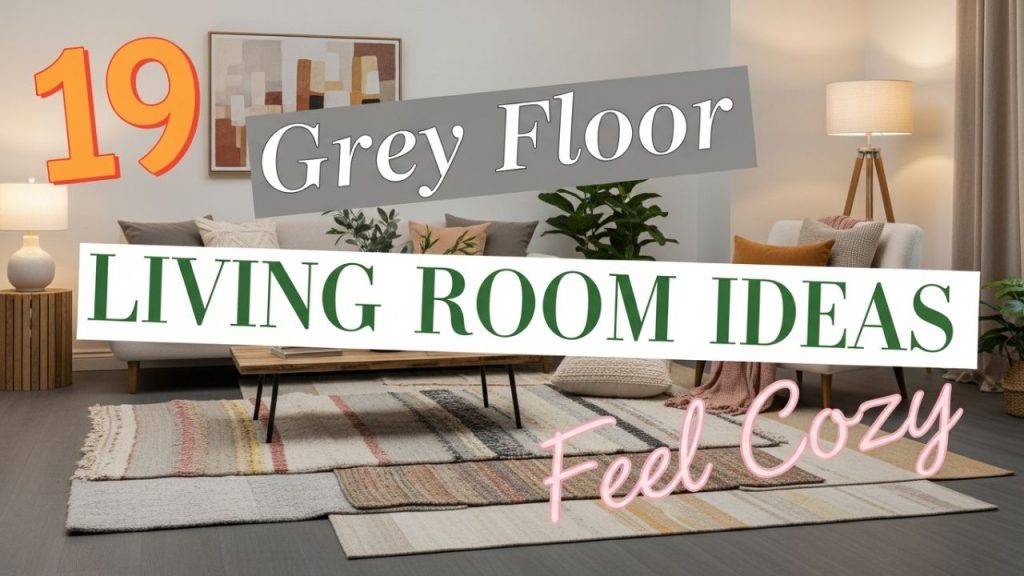Grey floors can feel cold and impersonal—but they don’t have to. When styled the right way, grey flooring can serve as the perfect neutral canvas to create a warm, inviting, and genuinely cozy living room.
Whether you’re working with tile, laminate, wood, or carpet in grey tones, this list will give you actionable design ideas that go beyond the basics.
Let’s dive into 19 proven, stylish, and cozy grey floor living room ideas—along with how to get it right (and what to avoid).

Table of Contents
1. Layer a Soft Neutral or Beige Rug
Why it works: Grey floors can feel too sleek or industrial. Layering a warm, neutral rug softens the look instantly.
How to do it:
- Choose a rug in cream, beige, or light taupe tones.
- Make sure the rug is plush—think shag, wool, or high-pile.
- Layer it large enough to anchor your seating area.
What not to do: Avoid small rugs that “float” under your coffee table. It should touch the front legs of your sofa at least.
2. Add Wood Accents for Warmth
Why it works: Wood tones naturally balance the cool undertones of grey, adding a cozy, earthy feel.
How to do it:
- Add a wooden coffee table, floating shelf, or sideboard.
- Mix light oak for a Scandi feel or walnut for richer warmth.
- Try wood picture frames or lamp bases for detail.
What not to do: Don’t go overboard—too much wood can clash with grey instead of complementing it.
3. Use Off-White or Cream Walls
Why it works: White walls with grey floors can look stark. Off-white adds softness and warmth.
How to do it:
- Try warm whites like Benjamin Moore’s “Swiss Coffee.”
- Keep ceilings and trims a true white for subtle contrast.
What not to do: Avoid pairing grey floors with grey walls unless the tone is very warm.
4. Introduce Texture Through Textiles
Why it works: Cozy rooms rely on touchable surfaces—blankets, pillows, and curtains with texture add life to a grey base.
How to do it:
- Mix knits, linen, boucle, and faux fur.
- Use at least 2–3 textures in your sofa area.
- Include floor-length curtains for softness.
What not to do: Don’t use too many slick fabrics like leather or polyester—it defeats the purpose.
5. Bring in Olive or Forest Green Accents
Why it works: Green adds natural coziness without overpowering grey. It’s earthy and calming.
How to do it:
- Try green velvet pillows or a deep green armchair.
- Add potted indoor plants with matte green leaves.
What not to do: Neon or minty greens feel too cool and may clash with grey tones.
6. Use Warm Ambient Lighting
Why it works: Grey reflects light differently. Warm lighting brings a glow that counters any coldness.
How to do it:
- Use lamps with warm LED bulbs (2700–3000K).
- Add string lights, sconces, or uplighting behind furniture.
What not to do: Overhead white light (like cool fluorescents) will make everything feel sterile.
7. Paint an Accent Wall in Deep Taupe
Why it works: Taupe blends brown and grey, warming up the space subtly without strong contrast.
How to do it:
- Choose one wall behind the sofa or TV.
- Use matte or eggshell finish for a cozier look.
What not to do: Don’t use a stark black or navy unless you’re going for drama over comfort.
8. Include a Cozy Reading Nook
Why it works: A dedicated space for relaxing naturally makes the room feel cozier.
How to do it:
- Use a soft chair, blanket, and small side table.
- Add a floor lamp or table lamp nearby.
What not to do: Don’t over-clutter it—keep it simple and functional.
9. Add Personal Art or Family Photos
Why it works: Personal touches make a space feel lived-in and loved—coziness is emotional too.
How to do it:
- Use mismatched frames for an organic gallery wall.
- Choose warm wood or brass frames to contrast the grey.
What not to do: Avoid overly abstract or cold art in black-and-white—it can make the space feel distant.
10. Use Earthy Accent Colors (Terracotta, Mustard)
Why it works: Earthy tones warm up the coolness of grey and create inviting depth.
How to do it:
- Try terracotta throw pillows or a mustard knit blanket.
- Add pottery in rust, amber, or ochre.
What not to do: Don’t mix more than 2–3 warm accent tones; too many will feel chaotic.
11. Go All In With a Cozy Sectional Sofa
Why it works: Sectionals create an intimate, enclosed seating space that feels snug.
How to do it:
- Choose plush, deep cushions.
- Opt for upholstery in warm greys, beiges, or olive.
What not to do: Avoid tight or angular modern designs with thin cushions.
12. Incorporate Matte Black Metal
Why it works: Black adds contrast and grounding to grey without overpowering the room.
How to do it:
- Add a matte black coffee table frame or curtain rods.
- Try black framed art or mirror outlines.
What not to do: Don’t overdo it or go glossy—it can feel industrial instead of cozy.
13. Keep Clutter in Hidden Storage
Why it works: Cozy doesn’t mean messy. Clutter can make small spaces feel chaotic.
How to do it:
- Use storage ottomans, baskets, and furniture with drawers.
- Stick to a consistent basket color and material (like wicker).
What not to do: Avoid open shelves packed with random objects.
14. Add Layers to Your Lighting
Why it works: More light = more warmth. Multiple sources help create mood and flexibility.
How to do it:
- Mix floor lamps, table lamps, sconces, and candles.
- Dimmer switches are ideal.
What not to do: Avoid relying on just one overhead light.
15. Introduce Cozy Scents and Natural Materials
Why it works: Cozy is a full sensory experience—what you smell affects how you feel.
How to do it:
- Use candles, oil diffusers, or incense in warm scents (vanilla, sandalwood, amber).
- Mix in wool throws, wooden trays, and linen covers.
What not to do: Avoid artificial scents or sterile room sprays.
16. Mix in Vintage or Rustic Pieces
Why it works: A little age adds character and charm, making the space feel lived-in.
How to do it:
- Add a vintage trunk, rustic wood bench, or thrifted decor.
- Blend old with new intentionally.
What not to do: Don’t let it feel too mismatched—anchor it with clean-lined main furniture.
17. Go Monochrome—With Layers of Grey
Why it works: Different shades of grey can feel soothing when layered intentionally.
How to do it:
- Use light grey walls, medium grey furniture, and dark grey curtains.
- Add texture through patterns (herringbone, waffle, knit).
What not to do: Avoid flat, one-tone grey—it’s the layering that creates depth.
18. Keep It Low and Grounded
Why it works: Lower seating and furniture make a room feel more relaxed and intimate.
How to do it:
- Choose sofas and chairs with lower legs.
- Use floor cushions or poufs for added casual comfort.
What not to do: Avoid overly tall or bulky furniture that makes the room feel stiff.
19. Embrace Natural Light and Views
Why it works: Natural light softens grey and adds warmth—no effort required.
How to do it:
- Keep window treatments light and airy.
- Place mirrors opposite windows to reflect light.
What not to do: Don’t block windows with tall furniture or heavy drapes.
Conclusion: Cozy and Grey Can Coexist
A grey floor doesn’t mean you have to settle for a cold or lifeless living room. In fact, with the right textures, lighting, colors, and personal touches, grey floors can serve as the perfect base for a warm, welcoming, and deeply cozy space.
Whether you’re layering in a soft rug, adding olive green accents, or warming things up with taupe walls and wood tones—each of these 19 ideas proves that coziness isn’t about color alone. It’s about how you style it.
Start with one or two changes, build gradually, and watch your living room transform into the kind of space you won’t want to leave.








